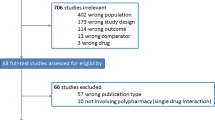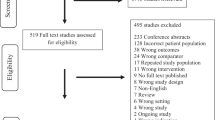Abstract
Background
Levetiracetam is widely used in post-stroke epilepsy. However, it is suspected to possess P-glycoprotein (P-gp) induction properties, and therefore, a potentially significant interaction with direct oral anticoagulants (DOACs). We aimed to search for ischemic stroke signals with levetiracetam and the DOACs.
Methods
In this retrospective pharmacovigilance study, we used the FAERS database to identify ischemic stroke events associated with DOACs and concomitant use of levetiracetam. We evaluated disproportionate reporting by the adjusted reporting odds ratio (adjROR) and the lower bound of the shrinkage 95% confidence interval. When shrinkage is positive, an increased risk of a specific adverse event occurrence is emphasized over the sum of the individual risks when these same drugs are used separately.
Results
We identified 1841 (1.5%), 3731 (5.3%), 338 (4.9%), and 1723 (1.3%) ischemic stroke reports with apixaban, dabigatran, edoxaban, and rivaroxaban, respectively. The adjROR of the interaction effect was 3.57 (95% CI 2.81–4.58) between DOACs and levetiracetam. The shrinkage analysis detected an interaction between each of the DOACs and levetiracetam. The logistic model and shrinkage analysis failed to detect an interaction when queried for hemorrhagic stroke. A significant signal in the classical enzyme inducer, carbamazepine, strengthened our results (adjROR; 8.47, 95% CI 5.37–13.36).
Conclusions
Our study shows a strong signal for the levetiracetam interaction with the DOACs. Our findings suggest implementation of a drug monitoring strategy.

Similar content being viewed by others

References
Hindricks G, Potpara T, Dagres N, Arbelo E, Bax JJ, Blomström-Lundqvist C, Boriani G, Castella M, Dan G-A, Dilaveris PE, Fauchier L, Filippatos G, Kalman JM, La Meir M, Lane DA, Lebeau J-P, Lettino M, Lip GYH, Pinto FJ, Thomas GN, Valgimigli M, Van Gelder IC, Van Putte BP, Watkins CL. ESC Scientific Document Group, 2020 ESC Guidelines for the diagnosis and management of atrial fibrillation developed in collaboration with the European Association for Cardio-Thoracic Surgery (EACTS): The Task Force for the diagnosis and management of atrial fibrillation of the European Society of Cardiology (ESC) Developed with the special contribution of the European Heart Rhythm Association (EHRA) of the ESC. Eur Heart J. 2021;42(5):373–498. https://doi.org/10.1093/eurheartj/ehaa612.
Chan N, Sobieraj-Teague M, Eikelboom JW. Direct oral anticoagulants: evidence and unresolved issues. Lancet. 2020;396(10264):1767–76. https://doi.org/10.1016/S0140-6736(20)32439-9.
Chang RS, Leung WC, Vassallo M, Sykes L, Battersby Wood E, Kwan J. Antiepileptic drugs for the primary and secondary prevention of seizures after stroke. Cochrane Database Syst Rev. 2022;2(2): CD005398. https://doi.org/10.1002/14651858.
Camilo O, Goldstein LB. Seizures and epilepsy after ischemic stroke. Stroke. 2004;35(7):1769–75. https://doi.org/10.1161/01.STR.0000130989.17100.96. (Epub 2004 May 27).
DeLorenzo RJ, Hauser WA, Towne AR, Boggs JG, Pellock JM, Penberthy L, Garnett L, Fortner CA, Ko D. A prospective, population-based epidemiologic study of status epilepticus in Richmond, Virginia. Neurology. 1996;46(4):1029–35.
Herman ST. Epilepsy after brain insult: targeting epileptogenesis. Neurology. 2002;59(9 Suppl 5):S21–6. https://doi.org/10.1212/wnl.59.9_suppl_5.s21.
Ruff CT, Giugliano RP, Braunwald E, Hoffman EB, Deenadayalu N, Ezekowitz MD, Camm AJ, Weitz JI, Lewis BS, Parkhomenko A, Yamashita T, Antman EM. Comparison of the efficacy and safety of new oral anticoagulants with warfarin in patients with atrial fibrillation: a meta-analysis of randomised trials. Lancet. 2014;383(9921):955–62. https://doi.org/10.1016/S0140-6736(13)62343-0.
Steffel J, Verhamme P, Potpara TS, Albaladejo P, Antz M, Desteghe L, Haeusler KG, Oldgren J, Reinecke H, Roldan-Schilling V, Rowell N, Sinnaeve P, Collins R, Camm AJ, Heidbüchel H, ESC Scientific Document Group. The 2018 European Heart Rhythm Association Practical Guide on the use of non-vitamin K antagonist oral anticoagulants in patients with atrial fibrillation. Eur Heart J. 2018;39(16):1330–93.
Jan Steffel and others. 2021 European Heart Rhythm Association Practical Guide on the use of non-vitamin K antagonist oral anticoagulants in patients with atrial fibrillation. EP Europace. 2021;23(10):1612–76. https://doi.org/10.1093/europace/euab065.
Larsson D, Baftiu A, Johannessen Landmark C, von Euler M, Kumlien E, Åsberg S, Zelano J. Association between antiseizure drug monotherapy and mortality for patients with poststroke epilepsy. JAMA Neurol. 2022;79(2):169–75. https://doi.org/10.1001/jamaneurol.2021.4584.
Paciullo F, Costa C, Gresele P. Rivaroxaban plasma levels and levetiracetam. Ann Intern Med. 2020;173(9):772. https://doi.org/10.7326/L20-1066.
Giustozzi M, Mazzetti M, Paciaroni M, et al. Concomitant use of direct oral anticoagulants and antiepileptic drugs: a prospective cohort study in patients with atrial fibrillation. Clin Drug Investig. 2021;41:43–51. https://doi.org/10.1007/s40261-020-00982-8.
Gronich N, Stein N, Muszkat M. Association between use of pharmacokinetic-interacting drugs and effectiveness and safety of direct acting oral anticoagulants: nested case-control study. Clin Pharmacol Ther. 2021;110(6):1526–36. https://doi.org/10.1002/cpt.2369.
FAERS database. https://www.fda.gov/drugs/questions-and-answers-fdas-adverse-event-reporting-system-faers/fda-adverse-event-reporting-system-faers-public-dashboard. Accessed Feb. 2023.
Center for Drug Evaluation and Research. National Drug Code Directory. U.S. Food and Drug Administration. 2022. https://www.fda.gov/drugs/drug-approvals-and-databases/national-drug-code-directory. Accessed Feb. 2023.
van Puijenbroek EP, Bate A, Leufkens HG, Lindquist M, Orre R, Egberts AC. A comparison of measures of disproportionality for signal detection in spontaneous reporting systems for adverse drug reactions. Pharmacoepidemiol Drug Saf. 2002;11(1):3–10. https://doi.org/10.1002/pds.668.
Noguchi Y, Tachi T, Teramachi H. Review of statistical methodologies for detecting drug–drug interactions using spontaneous reporting systems. Front Pharmacol. 2019;8(10):1319. https://doi.org/10.3389/fphar.2019.01319.
Norén GN, Sundberg R, Bate A, Edwards IR. A statistical methodology for drug–drug interaction surveillance. Stat Med. 2008;27(16):3057–70. https://doi.org/10.1002/sim.3247. (Erratum in: Stat Med. 2008 Dec 20;27(29):6271-2).
Apixaban Physician Guidance. https://www.medicines.org.uk/emc/product/2878/smpc#gref. Accessed Feb. 2023.
Apixaban Physician Guidance. FDA. https://dailymed.nlm.nih.gov/dailymed/drugInfo.cfm?setid=095a08ac-cf0e-497e-a682-ddef38d6b29c#Section_5.3. Accessed, Feb. 2023.
Bolek T, Samoš M, Škorňová I, et al. Does proton pump inhibition change the on-treatment anti-Xa activity in xabans-treated patients with atrial fibrillation? A pilot study. J Thromb Thrombolysis. 2019;47:140–5. https://doi.org/10.1007/s11239-018-1748-5.
Kaba RA, Ara F, Ward DE, Emanuel S. The dabigatran debate. Glob Cardiol Sci Pract. 2014;2014(3):254–6. https://doi.org/10.5339/gcsp.2014.41.
Perlman A, Wanounou M, Goldstein R, Choshen Cohen L, Singer DE, Muszkat M. Ischemic and thrombotic events associated with concomitant xa-inhibiting direct oral anticoagulants and antiepileptic drugs: analysis of the FDA Adverse Event Reporting System (FAERS). CNS Drugs. 2019;33(12):1223–8. https://doi.org/10.1007/s40263-019-00677-5.
Rivaroxaban Physician Guidance: https://www.medicines.org.uk/emc/product/2793/smpc#gref. Accessed, Aug. 2023.
Giner-Soriano M, Marsal JR, Gomez-Lumbreras A, Morros R. Risk of ischaemic stroke associated with antiepileptic drugs: a population-based case-control study in Catalonia. BMC Neurol. 2021;21:208.
Menichelli D, Pastori D, Pignatelli P, Pani A. Minimizing drug-drug interactions between dabigatran and levetiracetam through clinical management: a case report. Eur Heart J Case Rep. 2023;7(1): ytad006. https://doi.org/10.1093/ehjcr/ytad006.
Mavri A, Ilc S. The efficacy of direct oral anticoagulants in patients on concomitant treatment with levetiracetam. Sci Rep. 2023;13(1):9257. https://doi.org/10.1038/s41598-023-33876-8.
Mendoza Aguilera M, Bellés Medall MD, Álvarez Martín T, Pascual Marmaneu Ó, LiñanaGranell C, Ferrando PR. Therapeutic drug monitoring of levetiracetam in daily clinical practice: high-performance liquid chromatography versus immunoassay. Eur J Hosp Pharm. 2020;27(e1):e2–6. https://doi.org/10.1136/ejhpharm-2018-001616.
Ip BY, Ko H, Wong GL, Yip TC, Lau LH, Lau AY, Leng X, Leung H, Chan HH, Chan HY, Mok VC, Soo YO, Leung TW. Thromboembolic risks with concurrent direct oral anticoagulants and antiseizure medications: a population-based analysis. CNS Drugs. 2022;36(12):1313–24. https://doi.org/10.1007/s40263-022-00971-9.
Mathy FX, Dohin E, Bonfitto F, Pelgrims B. Drug-drug interaction between levetiracetam and non-vitamin K antagonist anticoagulants. Eur Heart J. 2019;40(19):1571. https://doi.org/10.1093/eurheartj/ehy780.
Levy RH, Ragueneau-Majlessi I, Baltes E. Repeated administration of the novel antiepileptic agent levetiracetam does not alter digoxin pharmacokinetics and pharmacodynamics in healthy volunteers. Epilepsy Res. 2001;46(2):93–9. https://doi.org/10.1016/s0920-1211(01)00253-4.
Teng CM, Yeh HI, Lee LG. Anticoagulant and antiplatelet properties of piracetam. Taiwan Yi Xue Hui Za Zhi. 1983;82(11):1104–14.
Wang CL, Wu VC, Chang KH, Tu HT, Kuo CF, Huang YT, Chu PH, Kuo CC, Chang SH. Assessing major bleeding risk in atrial fibrillation patients concurrently taking non-vitamin K antagonist oral anticoagulants and antiepileptic drugs. Eur Heart J Cardiovasc Pharmacother. 2020;6(3):147–54. https://doi.org/10.1093/ehjcvp/pvz035.
French JA, Gazzola DM. New generation antiepileptic drugs: what do they offer in terms of improved tolerability and safety? Ther Adv Drug Saf. 2011;2(4):141–58. https://doi.org/10.1177/2042098611411127.
Sarode R. Direct oral anticoagulant monitoring: what laboratory tests are available to guide us? Hematol Am Soc Hematol Educ Program. 2019;2019(1):194–7. https://doi.org/10.1182/hematology.2019000027.
Goldstein R, Jacobs AR, Zighan L, Gronich N, Bialer M, Muszkat M. Interactions between direct oral anticoagulants (DOACs) and antiseizure medications: potential implications on DOAC treatment. CNS Drugs. 2023;37(3):203–14. https://doi.org/10.1007/s40263-023-00990-0.
FDA: Studies show increased risk of heart rhythm problems with seizure and mental health medicine lamotrigine (Lamictal) in patients with heart disease. https://www.fda.gov/drugs/drug-safety-and-availability/studies-show-increased-risk-heart-rhythm-problems-seizure-and-mental-health-medicine-lamotrigine. Accessed Sep. 2022.
Pradaxa lawsuit. https://www.drugwatch.com/pradaxa/lawsuits/. Accessed Feb. 2023.
Lau WCY, Torre CO, Man KKC, Stewart HM, Seager S, Van Zandt M, Reich C, Li J, Brewster J, Lip GYH, Hingorani AD, Wei L, Wong ICK. Comparative effectiveness and safety between apixaban, dabigatran, edoxaban, and rivaroxaban among patients with atrial fibrillation: a multinational population-based cohort study. Ann Intern Med. 2022;175(11):1515–24. https://doi.org/10.7326/M22-0511.
Yao X, Abraham NS, Sangaralingham LR, Bellolio MF, McBane RD, Shah ND, Noseworthy PA. Effectiveness and safety of dabigatran, rivaroxaban, and apixaban versus warfarin in nonvalvular atrial fibrillation. J Am Heart Assoc. 2016;5(6): e003725. https://doi.org/10.1161/JAHA.116.003725.
Harrington J, Carnicelli AP, Hua K, Wallentin L, Patel MR, Hohnloser SH, Giugliano RP, Fox KAA, Hijazi Z, Lopes RD, Pokorney SD, Hong H, Granger CB. Direct oral anticoagulants versus warfarin across the spectrum of kidney function: patient-level network meta-analyses from COMBINE AF. Circulation. 2023;147(23):1748–57. https://doi.org/10.1161/CIRCULATIONAHA.122.062752.
Chen A, Stecker E, Warden BA. Direct oral anticoagulant use: a practical guide to common clinical challenges. J Am Heart Assoc. 2020;9(13): e017559. https://doi.org/10.1161/JAHA.120.017559. (Epub 2020 Jun 15).
Perlman A, Goldstein R, Choshen Cohen L, Hirsh-Raccah B, Hakimian D, Matok I, Kalish Y, Singer DE, Muszkat M. Effect of enzyme-inducing antiseizure medications on the risk of sub-therapeutic concentrations of direct oral anticoagulants: a retrospective cohort study. CNS Drugs. 2021;35(3):305–16. https://doi.org/10.1007/s40263-021-00795-z.
Acknowledgments
We acknowledge the support of Professor Ilan Matok, Chairman of the Clinical Pharmacy Program, Faculty of Medicine, Hebrew University of Jerusalem. Preprints of this work have been posted in MedRxiv: www.medrxiv.org/content/10.1101/2023.08.21.23294397v1.full.pdf; https://www.medrxiv.org/content/10.1101/2023.08.21.23294397v1.
Author information
Authors and Affiliations
Corresponding author
Ethics declarations
Funding
No external funding was used in the preparation of this manuscript.
Conflict of Interest
Mohammed Aboukaoud, Ran Nissan, Amitai Segev, Avi Sabbag, David Orion, and Elad Maor have no potential conflicts of interest that might be relevant to the contents of this manuscript.
Data Availability Statement
The datasets generated during and/or analyzed during the current study are available in the FAERS repository. https://www.fda.gov/drugs/questions-and-answers-fdas-adverse-event-reporting-system-faers/fda-adverse-event-reporting-system-faers-public-dashboard.
Author Contributions
Mohammed Aboukaoud is responsible for the data collection, statistical analysis, and manuscript writing. Ran Nissan, expert in pharmacotherapy, participated in writing and reviewing the manuscript. Amitai Segev, Avi Sabbag, and Elad Maor, experts in Cardiology, participated in writing and reviewing the manuscript. David Orion is a Neurologist who reviewed the manuscript.
Ethics Approval
Not applicable. The FAERS Public Dashboard is a publicly available web-based tool containing mandatory data reports from drug manufacturers and voluntary ADR reports from consumers and healthcare professionals. Hence an informed consent or ethical statement of approval by an ethical standards committee on human experimentation is not required for analysis.
Code Availability
Not applicable.
Consent to Participate
Not applicable.
Consent for Publication
Not applicable.
Rights and permissions
Springer Nature or its licensor (e.g. a society or other partner) holds exclusive rights to this article under a publishing agreement with the author(s) or other rightsholder(s); author self-archiving of the accepted manuscript version of this article is solely governed by the terms of such publishing agreement and applicable law.
About this article
Cite this article
Abou Kaoud, M., Nissan, R., Segev, A. et al. Levetiracetam Interaction with Direct Oral Anticoagulants: A Pharmacovigilance Study. CNS Drugs 37, 1111–1121 (2023). https://doi.org/10.1007/s40263-023-01052-1
Accepted:
Published:
Issue Date:
DOI: https://doi.org/10.1007/s40263-023-01052-1



